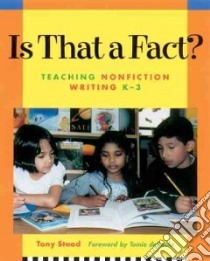Is That a Fact? - 9781571103314
Un libro in lingua di Tony Stead dePaola Tomie (FRW) edito da Stenhouse Pub, 2001
- € 22.40
- Il prezzo è variabile in funzione del cambio della valuta d’origine
The book you are about to read is destined to be the first, middle, and maybe even the last word on nonfiction writing for young, young children. It is certainly a text that you will return to over and over again as you do with a beloved cookbook.
?from the Foreword by Tomie dePaola
Over eighty- five percent of the reading and writing we do as adults is nonfiction, yet most of the reading and writing in K?3 classrooms is fiction or personal narrative. In Is That a Fact? Teaching Nonfiction Writing K-3, Tony Stead shows you how to open the door to the rich world of nonfiction writing that goes beyond "what I did" narratives and animal reports. And he convincingly demonstrates the importance of introducing nonfiction writing in the primary grades.
Nonfiction inspires enthusiasm in young children because they can choose topics that are of interest to them personally. Is That a Fact? explores a variety of authentic purposes for writing nonfiction, such as describing, explaining, instructing, persuading, retelling, and exploring relationships with others. You will learn how to introduce each purpose using a variety of forms, including letters, reports, poetry, captions, directions, and interviews.
Part One provides a complete overview of teaching nonfiction writing in the primary grades and includes:
- practical ways for organizing nonfiction resources within the classroom;
- how to assist children in collecting information for research;
- ideas for helping children keep their sense of voice when writing nonfiction;
- a chapter on spelling, with examples of how to guide students at each stage of spelling development;
- strategies for assessment and evaluation that guide teaching and learning engagements.
Part Two provides five different explorations that were implemented in actual K?3 classrooms. Each focuses on a specific purpose for writing nonfiction and features:
- examples of whole-class, small-group, and independent instructional engagements;
- a comprehensive assessment rubric that will help teachers tailor instruction to the needs of all learners;
- an extensive resource section that includes lists of books in the exploration, grouped by readability levels;
- answers to the most commonly asked questions about teaching nonfiction writing.
The appendixes include a self-assessment questionnaire, reproducible pages for exploring specific writing forms, and letters to parents.
Children need to be introduced to the different purposes of nonfiction writing. They need to know how to plan, compose, revise, and publish nonfiction beyond narrative. Is That a Fact? guides you in achieving these goals with your students.
Informazioni bibliografiche
- Titolo del Libro in lingua: Is That a Fact?
- Sottotitolo: Teaching Nonfiction Writing K-3
- Lingua: English
- Autori : Tony Stead dePaola Tomie (FRW)
- Editore: Stenhouse Pub
- Collana: (Paperback)
- Data di Pubblicazione: 01 Gennaio '01
- Genere: EDUCATION
- Argomenti : English language Composition and exercises Study and teaching (Elementary Exposition (Rhetoric
- Pagine: 252
- Dimensioni mm: 260 x 209 x 19
- ISBN-10: 1571103317
- EAN-13: 9781571103314


